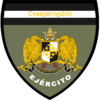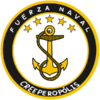Mara War
The Mara War, also referred to as the Creeperian Drug War and the Paramilitary War,[note 3] is a major ongoing asymmetric military conflict occurring in Sur, primarily in Creeperopolis. The high-intensity conflict is being fought between the Creeperian government, anti-government paramilitaries (composed of drug cartels, criminal gangs, etc.), and various semi-government aligned death squads.
The conflict began on 15 October 1979 with a declaration of war, issued by Creeperian Emperor Adolfo V, which called for the "elimination" of Creeperopolis' criminal gangs which had grown powerful enough to effectively govern some parts of the country. The declaration was made following the assassination of Agustín López Cabrera, the captain general of Zapatista, by Mara Salvatrucha earlier in the month for strict measures he implemented against gang activity in the department.
The Creeperian government has stated that the primary purpose of the conflict is to "destroy terroristic paramilitary and criminal threats to the Fatherland." Since the declaration of war, dozens of criminal organizations eventually evolved to form into paramilitaries to directly challenge the government, with some groups openly stating their intentions are to topple the Creeperian government entirely. Additionally, various anti-paramilitary groups formed which primarily target and murder members of the paramilitaries, earning them the label of being death squads. The death squads, because of their intentions of eliminating the paramilitaries, have effectively become semi-aligned with the Creeperian government, as the government effectively ignores the actions of the death squads so long as they target the paramilitaries and not civilians or government forces.
Despite government efforts to bring the conflict to an end, it has gone on for over 44 years, making it one of the longest ongoing armed conflicts, and has resulted in the deaths of anywhere between 1.7 million to 2.4 million people, making it the deadliest ongoing armed conflict (including deaths as a result of organized crime). Legally, however, the Creeperian government does not consider members of the paramilitaries to be human beings which allows people to murder them without any legal consequences in some sort of effort to deter individuals from joining the cartels and encouraging people to take justice into their own hands. This official policy of the Creeperian government has been almost universally condemned by the international community as a severe violation of human rights.
As a part of Creeperopolis' campaign to dehumanize paramilitary members, anyone arrested by the Creeperian government who is discovered to be a member of a paramilitary is automatically given a 70-year prison sentence, while those convicted of a violent crime are imprisoned for life or executed, with some being extrajudicially executed by the military or police.
Contents
Names
The conflict between the Creeperian government and the various criminal gangs in the country is most commonly called the "Mara War" in the Jackian language. The phrase is usually translated from the Creeperian phrases "Guerra Marero" (Creeperian: Գփերրա Մարերո), "Guerra de las'Maras" (Գփերրա դե լաս'Մարաս), and "Guerra contra las'Maras" (Գփերրա ծոնտրա լաս'Մարաս). Also used to a lesser degree is the "Gang War" (Գփերրա Պանդիժերո, Guerra Pandillero), as in Creeperian, the term mara has become synonymous with the world for gang (պանդիժա, pandilla).
Due to the conflict's heavy association with the trafficking of illegal drugs and narcotics, the war has also been called the "Creeperian Drug War" (Գփերրա ծոնտրա'լ Նարծոտրըֆիծո Ծրեեպերիանո, Guerra contra'l Narcotráfico Creeperiano) both inside and outside of Creeperopolis. Within Creeperopolis, simply the "Drug War" (Գփերրա Նարծոտրըֆիծո, Guerra Narcotráfico) is more frequently used when referring to the conflict as a drug war. Less common names given to the conflict include the "Paramilitary War" (Գփերրա Պարամիլիտար, Guerra Paramilitar), the Zapatista War (Գփերրա Զապատիստա, Guerra Zapatista), and the "War Against Criminality and Terrorism" (Գփերրա ծոնտրա'լ Ծրիմինալիդադ յ Տերրորիսմո, Guerra contra'l Criminalidad y Terrorismo).
Background
Following the conclusion of the Creeperian Civil War in September 1949, a period of low-level insurgent-like conflict began in Creeperopolis, known as the "Partisan Resistance", between the right-wing Creeperian government established by the Catholic Imperial Restoration Council (also called the Romerists) and left-wing guerrilla movements who were mostly composed of former soldiers of the National Council for Peace and Order (also called the Miguelists). Many Creeperans believed that the internal conflict which had raged in Creeperopolis since 1933 had not yet completed, and as such, some Creeperans formed and joined self-defense groups composed of armed civilians who would protect their group's members from guerrilla attacks. Overtime, said self-defense groups evolved into criminal gangs and began engaging in criminal activities and violence against rival gangs.
Alfonso Cabañeras Moreno, c. 1952
Initially, the Creeperian government welcomed the gangs, seeing them as vigilante groups which protected civilians from far-left partisan attacks. In 1952, Minister of Defense Alfonso Cabañeras Moreno expressed vocal support for the establishment and operations of gangs in the country, which he referred to as "self-defense militias". He acknowledged that some attacked the government and engaged in criminal activities, however, he stressed that they were a "useful tool" of the Creeperian government in combatting the remaining Miguelist influences in the country.
During the early and mid-1950s, the Creeperian Imperial Police (PIC) recorded several instances of open combat between partisan groups and gangs throughout southern Creeperopolis, where most of the partisan resistance was occurring. A total of 463 engagements between gangs and partisans were recorded between 1951 and 1956. Most of the engagements which resulted in a partisan defeat were not investigated by the Creeperian government, and sometimes, individuals who were victims of gang activity were arrested under suspicious of being attacked by the gangs for being a Miguelist.
After the end of the partisan resistance in 1957, the government began to take a more strict approach on the criminal gangs and the activities they engaged in, as they were no longer inherently anti-partisan and anti-Miguelist forces and were evolving into true criminal organizations which committed violent crimes against civilians and government officials such as murder, rape, kidnapping, battery, armed robbery, among other crimes. The Creeperian government issued notices to the departmental police forces to take a "stricter stance" against criminal activity being undertaken by the self-defense groups and gangs, and began spreading anti-gang propaganda and public service announcements warning of the "dangers" of joining gangs.
Prelude
Late-1960s Zapatistan anti-gang policies
Part of a series on the |
|---|
| History of Creeperopolis |
 |
|
|
On 16 February 1968, Segismundo Peralta Linares, the mayor of Tuxtla Martínez, was kidnapped by a criminal gang. The Zapatista Departmental Police (PODEZA) launched a large-scale operation to search for Peralta Linares, however, the police eventually found his decapitated body on the outskirts of Panachor three days later on 19 February 1968. Above his corpse, on the wall next to which his body was found, the police found graffiti reading "Territorio 18" (translated as: "18's Territory"), in reference to the 18th Street Gang which was established sometime in the early-1950s.
The succeeding mayor, José Sierra Queipo, announced that the 18th Street Gang would be "eradicated" as a "punishment" for Peralta Llano's assassination, marking the first time any level of the Creeperian government took direct action to attempt to eliminate a criminal gang. In the following years, thousands of members of the gang were arrested by various police departments across Zapatista, resulting in many anti-government attacks being committed by 18th Street Gang. Some rival gangs supported the police's efforts to eliminate the 18th Street Gang, but coordination between the police and gangs was rare. Sierra Queipo's anti-gang actions eventually resulted in his assassination on 14 September 1970. Although the murder has never been officially solved, the Creeperian government highly suspects it was committed by a criminal gang.
Sierra Queipo's assassination led to Emmanuel Rosales Obregón, the captain general of Zapatista, to declare a state of emergency against gang activity. He ordered the departmental police to begin arresting any suspected gang member within the department and to sentence them to 30 years imprisonment for being members of criminal organizations. From late-1970 to early-1973, the Zapatistan government arrested an estimated 10,200 gang members and imprisoned them without trial. Many of those arrested were incarcerated at the Tuxtla Martínez–Panachor Maximum Correctional Facility (TMP), and the prison would later become a symbol of the government's anti-gang repression as most of its prisoners are gang members.
Lack of national government actions
From July to October 1973, seven mayors in Zapatista were murdered and a further two were kidnapped–ultimately never being located and were both declared legally dead. In response, the Cortes Generales, the national legislature of Creeperopolis, held an emergency session on 6 November 1973 where the legislature unanimously denounced the murders in Zapatista and ordered the Zapatista Departmental Police to further crackdown on gang activities within the department. The legislature additionally called upon the national police to do the same.
On 1 January 1974, Rosales Obregón declared that the 18th Street Gang and Los'Sureños were terrorist organizations, and that membership of either group was punishable by 70 years imprisonment up to death. Later that year in August 1974, the Creeperian Mafia was also listed as a terrorist organization by the Zapatistan government. He urged that the groups also be designated as terrorist organizations at the national level, but the legislature only proceeded with labelling the 18th Street Gang as a terrorist organization on 15 February 1975. At the time, the national government did not see criminal gangs as a major threat to stability and only labelled the 18th Street Gang as a terrorist organization due to its various attacks against politicians.
With the the outbreak of the Deltinian Insurgency in February 1976, the national government gave even less attention to the growing problems caused by criminal gangs in southern Creeperopolis as the secessionist war being waged by the Society of Deltinian Brothers and the Holy Army of al-Mutasim were seen as a greater threat to national security. Sometime in March 1976, Cabañeras Moreno is alleged to have stated, "[the gangs] do commit criminal acts, but in the event of massive Deltinian terroristic attacks or potential neo-Miguelist uprisings they must remain in place; all Creeperans are able to rehabilitated". After his death in July 1976, his son, Emmanuel Cabañeras Videla, succeeded him as minister of defense and continued his father's cautious approach with handling the gangs.
Assassination of Agustín López Cabrera

Rosales Obregón announced his intention to resign as captain general of Zapatista on 1 June 1978, citing his failing health and desire to retire from politics. To succeed him, Emperor Adolfo V selected Agustín López Cabrera, the then-mayor of Tuxtla Martínez, to succeed Rosales Obregón as captain general. López Cabrera was officially inaugurated as captain general on 2 July 1978, and shortly after taking office, he announced that he would increase crackdowns on criminal gang activity citing the national government's lack of a "sufficient" response.
In October 1978, the National Intelligence Directorate (DINA) established the Anti-Terrorist Brigade (BAT) to serve as a military police and an anti-terrorist task force. The brigade was formed to combat Deltinian terrorist extremists in the department of San Juan, but López Cabrera officially petitioned the DINA to have a division of the Anti-Terrorist Brigade focus on combatting criminal gangs in southern Creeperopolis. His petition was rejected by Cabañeras Videla, who stated that its forces were significantly more needed in San Juan. López Cabrera criticized Cabañeras Videla's decision, and responded by stating that the national government must "pay attention to the great threat [criminal gangs] sitting at the front step of San Salvador before it grows out of control".
Due to the government's lack of a response to his requests, López Cabrera authorized the formation of the Anti-Terrorist Unit (UAT) on 12 January 1979, a militarized branch of the Zapatista Departmental Police to specialize in carrying out anti-gang operations. The unit carried out its first operation on 15 April 1979 which resulted in the arrest of Julián Gaitán Molina, who was considered to be the leader of Los'Sureños in the city of Guazapa. The unit's next operation occurred on 9 June 1979 and ended in the assassination of Eduardo Yagüe Ortega, the leader of the Creeperian Mafia in Panachor.
A third operation occurred on 29 July 1979 which was intended to capture Ernesto Dávila Ortega, the leader of Mara Salvatrucha, then the third largest gang in the country after Los'Sureños and the 18th Street Gang. The operation failed, however, but did result in the capture of his brother, Juan Dávila Ortega, and the death of his brother-in-law, Jorge León Alvarado. The operation reportedly enraged Dávila Ortega, who accused the Zapatistan government of attempting to initiate a purge of those the government deemed a "liability" to its authority.
Dávila Ortega called for the death of López Cabrera and demanded the Creeperian government remove him from office. On 9 October 1979, while López Cabrera was departing from the Zapatista Departmental Palace in Tuxtla Martínez, armed gunmen opened fire upon his entourage. Police officers nearby returned fire upon the gunmen and forced them to flee the scene, but López Cabrera was struck twice in the chest and once in the neck. He was rushed to a nearby hospital, but was pronounced dead upon his arrival from severe blood loss. An additional two bodyguards were killed and a further six government employees and one journalist were injured during the attack.
Dávila Ortega publicly commended the assassination and announced that it was Mara Salvatrucha gunmen who carried out the assassination. He warned that, whoever López Cabrera's successor would be, that he must respect Mara Salvatrucha's authority and not encroach on their territory or curb their power. Many gangs across southern Creeperopolis also praised the assassination, but did not congratulate Mara Salvatrucha as they were still seen as a rival.
Course of the conflict
Reign of Adolfo V: 1979–1987
Declaration of war against the gangs
| Operation Genesis 19:24–25 |
|---|
The assassination of López Cabrera was universally condemned by the Creeperian government, and many Zapatistan politicians demanded that the national government finally take action against criminal gangs in the country. Thousands of civilians also marched in the streets across southern Creeperian cities demanding that the national government ensure their safety, as the gangs had been terrorizing Creeperian civilians for decades up to that point and the national government had failed to take action.
On 15 October 1979, Adolfo V held an emergency session of the Cortes Generales and ordered every member to attend. Also in attendance were many high-ranking government officials, such as Cabañeras Videla and Carlos Onganía Carballo, the minister of internal affairs. At the session, he named Felipe Tassis Mendoza as López Cabrera's successor. The legislature discussed the severity of the threat criminal gangs posed in Creeperopolis, now that a captain general had been assassinated by the gangs, and the legislature unanimously declared that membership in gangs would be formally illegal. The legislature also made the formation of gangs illegal, and announced that all criminal gang would be declared as terrorist organizations.
At the end of the session, Adolfo V made a final declaration, announcing a formal declaration of war against criminal gangs in the country. He stated that criminal gangs would be "eradicated" from the country, and that all its members only had the options to be imprisoned or die. He declared a "War Against Gangs and Criminality" and called upon Creeperans to reject the gangs and to resist their authority. Cabañeras Videla was forced to issue notices to the Creeperian Armed Forces, instructing them to prepare to engage in war with the criminal gangs as a part of Operation Genesis 19:24–25, which had been ongoing to repress anti-government activities since the end of the civil war. The declaration of war against the gangs by Adolfo V on 15 October 1979 is generally considered to be the beginning of the Mara War, and has since been considered by many historians as being a watershed event in Creeperian military, political, and social history.
Early-war mass arrests, killings, and attacks
Upon the declaration of war being signed ratified by the Creeperian government, the Creeperian Imperial Police, the various departmental and municipal police departments, and the Creeperian Army were ordered to begin a mass arrest campaign of gang members within the country. They were instructed to "search every single man between the ages of 12 and 45 and determine if they are a terrorist; if they are, immediately arrest them and imprison them for a minimum of 70 years". In the first week of the mass arrest order being issued, an estimated 8,000 people were arrested on accusations of being gang members. By 15 November 1979, one month after the declaration of war, an estimated 24,000 people were arrested.
MINLEY Directive 1980-000003, 1 January 1980
Many of those arrested were imprisoned at one of Creeperopolis' thirty maximum security prisons or one of the country's eight super-maximum security prisons. An estimated 500 to 1,000 of those arrested were killed by the country's security forces extrajudicially, killings which the government refused to prosecute. In some instances, the government praised the killings, and on 1 January 1980, with over 45,000 people arrested for being accused of having gang affiliations, the government ordered the prisons which incarcerated the gang members to "reduce" the gang population by 10 percent, which resulted in around 4,500 prisoners being killed in early-January 1980 in mass shootings across Creeperopolis' prisons.
Many international human rights groups and activists condemned the arrests and government-sanctioned killings as crimes against humanity and human rights violations, to which the Creeperian government responded by condemning those who criticized their actions as "endorsing criminality and terrorism" and "opposing justice and peace". The campaign of mass arrests officially ended on 1 February 1980, upon which Cabañeras Videla announced that "the immediate danger has now been eliminated, and anymore who wish to put themselves in war against the Fatherland will be individually eliminated".
Throughout the first few months of the mass arrests of gang members, the Creeperian government did not report any acts of "terrorism" which were committed within the country. The first government acknowledged act of terrorism occurred on 27 January 1980, just over four months after the declaration of war, when two armed gunmen opened fire at a police station in Panachor which killed 12 people and injured 24 more. Mara Salvatrucha claimed responsibility for the attack, stating, "the tyrannical state has begun a war it cannot win, and we will fight to defend the Creeperian people against this oppressive government". Although Mara Salvatrucha claimed to be defending the Creeperian people, the group then proceeded to stage another shooting at a Tuxtla Martínez shopping mall on 8 February 1980, which killed 8 people, all of whom were civilians.
As a direct response to the two shootings, Cabañeras Videla ordered each prison which had gang members within its population to execute 20 random gang members in retaliation for the 20 people killed in the two shootings. The public executions were carried out 10 February 1980, and the following day, Mara Salvatrucha detonated a car bomb outside a police station in Guazapa which killed 14 people. The first terrorist attack which was committed by a group other than Mara Salvatrucha occurred on 7 April 1980, when armed gunmen of the 18th Street Gang killed 3 soldiers in Denilla. The gang claimed to also be fighting against the government, but condemned Mara Salvatrucha for attacking civilians and subsequently declared war on the group.
Beginning of militarized inter-gang violence

On 1 July 1980, a car bomb was detonated in a neighborhood on the outskirts of Tuxtla Martínez. Once the Creeperian Imperial Police and the National Intelligence Directorate responded to the reported bombing, investigators discovered that the houses the bomb was detonated in front of belonged to members of Mara Salvatrucha, and not government officials or police officers as they initially believed. Shortly after the bombing, the 18th Street Gang claimed responsibility for the bombing, and announced that José Armando Linares y Ugaría, who they claimed ordered the mall shooting of February 1980, was killed during the bombing. Mara Salvatrucha responded to the 18th Street Gang's announcement by condemning the group, denouncing it as a terrorist organization. The bombing is the earliest confirmed instance of military-grade conflict being waged between the various criminal gangs in Creeperopolis.
The Creeperian government did not comment on the fighting between both groups, as the government saw it as "helpful" and "distracting". The government believed that the more the groups fought against the each other, the less they would attack government and military buildings, and the more casualties they would inflict upon each other. Following the car bombing, the armed forces and various police departments were ordered to not intervene in open conflicts between the gangs unless they "posed an immanent risk to civilian or government life". Arrests of individuals involved in attacks against gangs were less common than those involved in attacks against the government, due to the perceived "lower severity" of the attacks which were carried out against rival gangs.
A large three-way shootout occurred on 28 October 1980 in the outskirts of Tuxtla Martínez between Mara Salvatrucha, the 18th Street Gang, and Los'Zetas. The three groups all claimed that the district where the shootout occurred, known as Barrio San Jacinto, was under their influence and control, and the shootout occurred due to the groups fighting for definitive control of the district. The Creeperian Imperial Police and the Creeperian Army responded to the shootout quickly due to the shootout's magnitude and threat it posed to civilians in the area, and the shootout was forcibly ended by Creeperian security forces. The shootout, which lasted around 30 minutes, killed 75 people and injured 46 more, marking the largest gang shootout to that point. The government condemned the shootout and the "irresponsible threat" it posed to civilians, and praised the officers and soldiers who intervened to end it. Each group claimed victory in the shootout and condemned the government for stopping them from eliminating the other gangs and securing their control of the district. Five days after the shootout, Mara Salvatrucha detonated a car bomb outside army barracks in Tuxtla Martínez, however, it did not kill or injure anyone.
After the shootout and subsequent car bombing, the Cortes Generales passed a law which placed bounties on the leaders of ever criminal gang, offering rewards for their arrest or assassination. The government declared that the most immanent threat was that posed by Mara Salvatrucha, and the Imperial Court of Justice formally sentenced the group's leader, Dávila Ortega, to death. Similar sentences were issued to the leaders of the country's other gangs. On 5 January 1981, just over two months after the death sentences were formally made, Francisco Saynez Mendoza, the leader of the Los'Sureños gang, was assassinated during a car bombing by Los'Norteños. The group then demanded the ₡100 million colón (12.5 billion credit) reward for his assassination from the government, which the government refused to reward, stating that "terrorist organizations and members of said organizations are not eligible to claim government rewards".
Reign of Romero III: 1987–1999
Reign of Alfonso VI: 1999–2003
Reign of Alexander II: 2003–present
Combatants
Creeperian government
Armed forces
Police forces
Foreign support
Paramilitaries
List of notable paramilitaries
|
|
|
|
|
Death squads
List of notable death squads
Campaigns and policies
Government anti-paramilitary policies
Paramilitary recruitment and propaganda
Death squad recruitment activities
The various death squads in Creeperopolis have varying methods of recruiting new fighters. Most death squad members voluntarily joined due to their desire to kill those who they see as degenerate, undesirable, inferior, or traitors. An estimated 60 to 80 percent of death squad fighters are ex-soldiers who believed that the government was not going far enough in their anti-gang actions, or who wanted to continue fighting gangs after their discharge from the military. Because of their military experience, the country's death squads are considered to be "competent" fighting forces, and due to their extremist goals, they are also considered to be the country's most dangerous groups, as they have also been reported to attack ethnic and religious minorities, human rights workers, and foreign tourists as well.
Additionally, death squads have been known to abduct children from remote villages and forcibly conscript them to fight for their causes, using brainwashing and manipulation tactics to make the children adhere to their extremist beliefs. Many of the current high-ranking death squad leaders were abducted as children to fight for the death squads, and continued to fight due to their molded extremist beliefs that were instilled in them when they were young. An estimated 5 to 10 percent of the death squads' fighters are kidnapped and conscripted children.
Effects in Creeperopolis
Scale of casualties
Violence and crime
Government corruption
Treatment of journalists
Assassinations of government officials
Human trafficking
Internationally effects
Spillovers of violence
Destinations of trafficked drugs and weapons
See also
Notes
- ↑ Many of the paramilitaries are engages in conflict with each other; they are solely listed on the basis of being in conflict with the government.
- ↑ The death squads are generally allied with each other, however, they are in conflict with the paramilitaries and are not aligned.
- ↑ "Mara War": Գփերրա Մարերո – Guerra Marero, [ˈgeɾ.ra maˈɾe.ɾo]; "Creeperian Drug War": Գփերրա ծոնտրա'լ նարծոտրըֆիծո Ծրեեպերիանո – Guerra contra'l narcotráfico Creeperiano, [ˈgeɾ.ra ˈkon.tra-l naɾ.koˈtra.fi.ko kre.pe.ɾiˈa.no]; "Paramilitary War": Գփերրա Պարամիլիտար – Guerra Paramilitar, [ˈgeɾ.ra ˈpa.ɾa.mi.li.taɾ].
External links
![]() Media related to the Mara War at LCN Wiki
Media related to the Mara War at LCN Wiki
- Mara War (NSIndex; 6 October 2019) Creeperopólis
- Mara War (IIWiki; 1 March 2020) by Creeper
- Articles with short description
- Use dmy dates from February 2022
- Use Jackian from February 2022
- All LCNWiki articles written in Jackian
- Pages with broken file links
- Mara War
- Creeperopolis
- Creeperopolis RP
- Creeperopolis Terraconserva
- Terraconserva
- El Salvador
- Wars
- Deltino
- Creeperian Conflicts
- Wars involving Creeperopolis










